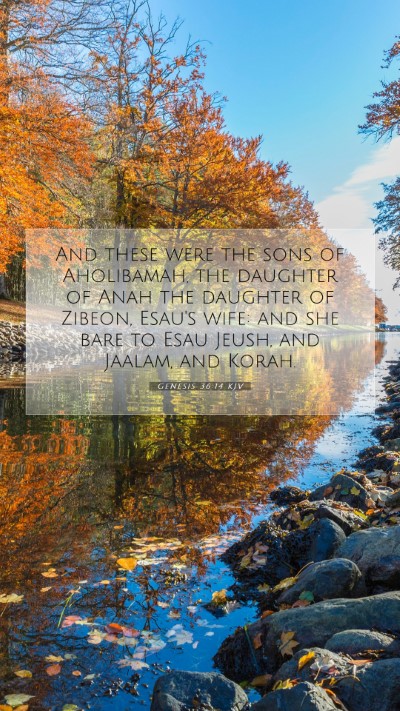Bible Verse Interpretation: Genesis 36:14
Genesis 36:14 reads, "And these were the sons of Aholibamah, the daughter of Anah, the son of Zibeon, Esau's wife: and she bare to Esau Jeush, and Jaalam, and Korah." In this verse, we find a genealogical record, which may seem tedious at first glance. However, the importance of genealogy in Scripture reveals deeper insights about identity, heritage, and God's unfolding plan.
Understanding the Context
In order to fully grasp the meaning of this verse, it's essential to consider the broader context of Genesis 36. This chapter outlines the descendants of Esau, also known as Edom, illustrating the fulfillment of God's promise to Abraham and Isaac regarding the multitude of descendants (Genesis 12:2-3). The genealogy highlights Esau's family, emphasizing the importance of lineage in both ancient cultures and biblical theology.
Genealogy and Its Significance
1. Identity and Heritage:
The genealogy serves to establish identity among the tribes of Israel and their related nations. Each name carries weight, linking individuals to their forebears and affirming their rightful place within the community. Understanding genealogies in the Bible helps clarify the significance of those who played pivotal roles in biblical history.
2. Fulfillment of Promise:
This verse contributes to the narrative of God's covenant with Abraham, which promised numerous descendants. The mention of Aholibamah, an important figure in the lineage of Esau, underscores God’s faithfulness in fulfilling His promises through generations.
Commentary Insights
-
Matthew Henry:
He emphasizes that genealogies, while often overlooked, play a crucial role in understanding the larger narrative of redemption. They document God's providence in guiding families and nations.
-
Albert Barnes:
Barnes points out that Aholibamah was a Hittite, indicating the intersection of different cultures and peoples in the lineage of Esau. This reflects God's plan for inclusion and the mingling of nations.
-
Adam Clarke:
Clarke notes the urgency of recognizing these verses as more than mere history, but as a testament to God's handiwork among humanity. Each name reflects God's design and purpose.
Cross References
- Genesis 36:1 - "Now these are the generations of Esau, who is Edom."
- Genesis 25:25 - "And the first came out red, all over like an hairy garment; and they called his name Esau."
- Romans 9:13 - "As it is written, Jacob have I loved, but Esau have I hated."
Application of Genesis 36:14
Understanding this verse allows us to see the importance of family and heritage in God's plan. The inclusion of various names reminds us that everyone has a part in God's story. It challenges readers to explore the significance of their heritage and how it shapes their identity within the larger narrative of faith.
Bible Study Resources
For those engaged in Bible study groups or looking for Bible study tools, exploring genealogies can provide rich insights. Online resources and commentary guides can greatly enhance Bible study insights and foster a deeper understanding of Scripture.
Conclusion
While Genesis 36:14 may initially appear as a simple record of names, it encapsulates powerful themes of identity, promise, and God's sovereignty in history. Studying such verses can yield profound insights into God's nature and His plans for humanity. Seek to delve deeper into these passages as part of your Bible study lessons and Bible study guides.


